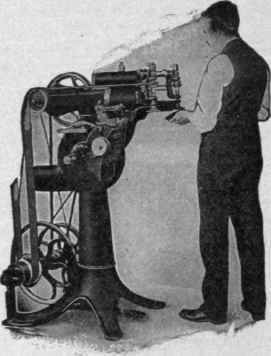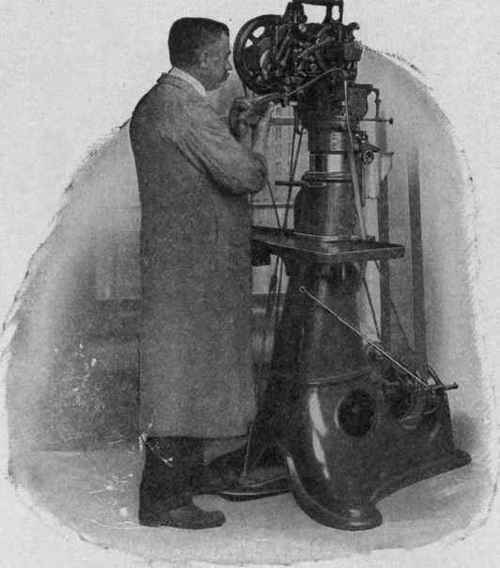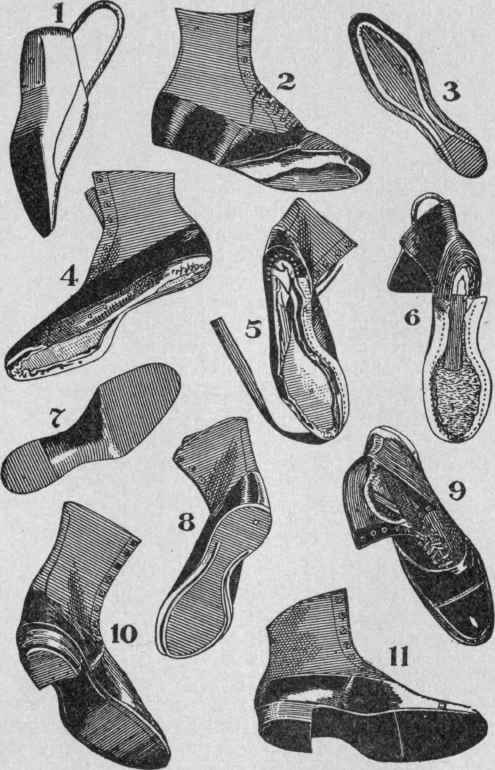The Story In The Making Of A Pair Of Shoes. Continued
Description
This section is from the book "The Wonder Book Of Knowledge", by Henry Chase. Also available from Amazon: Wonder Book of Knowledge.
The Story In The Making Of A Pair Of Shoes. Continued
The sole leather portions of the shoe pass through another series of machines, being cut from sides of sole leather by the dieing-out machine, cut to exact shape by the rounding machine and to exact thickness by the splitting machine, and then toughened by passing under a heavy rolling machine. These and other machines complete the soles and libels, which are finally sent to the making or bottoming room, where the completed shoe uppers awaits them.
The first process here is that of the ensign lacing machine, which puts a strong twine through the eyelets and ties it in an accurate manner. This is done very swiftly and exactly, its purpose being to hold the parts of the shoe in their normal position while the shoe is being completed. The last, made of wood, is now put in place and tacked fast by the insole tacking machine, when the upper is placed over it and fastened by two tacks to hold it in place. Then comes the pulling-over machine, the pincers of which draw the leather securely against the wood of the last, to which it is fastened by other tacks. These tacks in the upper are driven only part way in, so that they may be easily drawn out when no longer needed.
The welt lasting machine next takes the job in hand, it being almost humanlike in the evenness and tightness with which it draws the leather around the last, other tacks being driven partly in to hold it in place. A second lasting machine of different kind, draws it around the toe and heel. Then comes the upper trimming machines, which cuts away the surplus parts of the leather, the Rex pounding machine, which hammers it around the heel, the tack pulling machine which removes the lasting tacks and puts in others to hold the new placed leather, and the upper stapling machine, which forms a little staple fastening from wire which securely holds the shoe upper to the channel lip of the insole.
The shoe is now ready to receive the welt, a narrow strip of prepared leather which is sewed along the edge of the shoe and holds all its parts firmly together. This used to be one of the most difficult tasks in hand-work, but is done rapidly and exactly by this machine. After this all protruding parts of the welt and upper are trimmed off by another machine, the insole tack pulling machine removes all the remaining temporary tacks, and the welt-beating and slashing machines beats the welt with little hammers till it stands out evenly from the side of the shoe.
It may seem as if the number of machines engaged in this work are almost beyond number, but there are nearly as many more to come. In fact, a factory shoe in many cases is not completed until 170 machines and 210 pairs of hands have taken part in putting it together and getting it into shape for the wearer, and each of these machines works with an accuracy which no hand-work can equal. We have so far witnessed the assembling of the several parts of the shoe into one connected whole. The remaining processes must be run over more rapidly.
There is a sole-laying machine, a rounding and channeling machine, a loose nailing machine (the latter driving nails into the heel at the rate of 350 per minute), a heel seat rounding machine, and various others, one sewing the welt to the shoe, a leveling machine, a second nailing machine, which does the final work of attaching the heel to the shoe, and so on somewhat indefinitely.
The remaining machines have to do with the final finishing. They include trimmers, stitch separators, edge setters, buffers, finishers, cleaners, stampers, shoe treers, creasers, etc., each playing a part of some importance in giving a final finish

Edge Trimming Machine.

Climax Finishing Shaft.

Goodyear Heel Seat Rounding Machine.

Loose Nailing Machine.

The Hadaway Stitch Separating Machine.

Naumkeag Buffing Machine.

Regent Stamping Machine.

Goodyear Universal Rounding and Channeling Machine.

Goodyear Welt and Turn Shoe Machine.

Stitch and Upper Cleaning Machine.

Twin Edge Setting Machine.

Goodyear Outsole Rapid Lockstitch Machine.

Improved Vamp Creasing Machine.

Miller Show Treeing Machine.

The Evolution of a Goodyear Welt Shoe.
1. A last. 2. An upper. 3. An Insole. 4. Shoe lasted and ready to have welt sewed on. 5. Welt partly sewed on. 6. Welt entirely sewed on the shoe. 7. An outsole. 8. Shoe with outsole laid and rounded; channel lip turned up ready to be stitched. 9. Shoe with sole stitched on. 10. Shoe with heel in place. 11. Heel trimmed and shoe ready for finishing to the shoe and making it presentable to the wearer. The whole operation, as will be seen, is a highly complicated one, and is remarkably effective in preparing an article that shall appeal to the salesman and purchaser and prove satisfactory when put into use.
Such is the complicated process of making a shoe by machinery. It would be hard to find any machine process that surpasses it in complexity and the number of separate machines involved. Poor old St. Crispin would certainly expire with envy if he could see his favorite thus taken out of the hands of his artisans and the shoe whirled rapidly through a host of odd but effective contrivances on the way to become made fit for wear.
Continue to:


